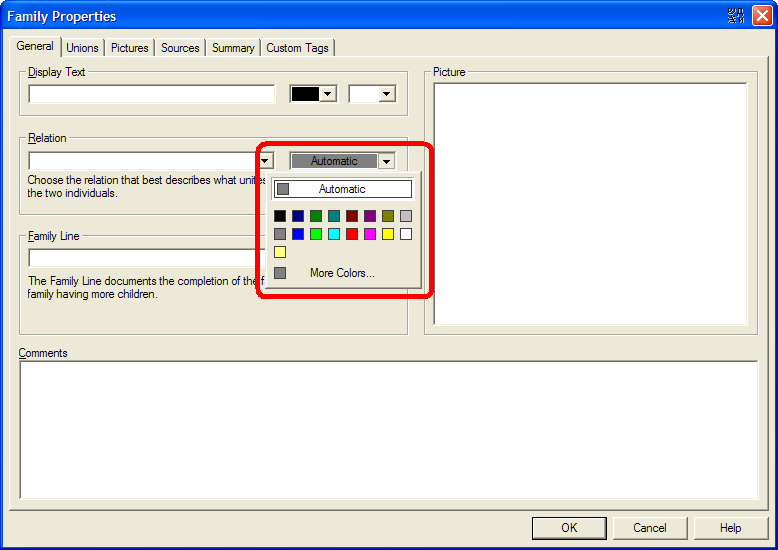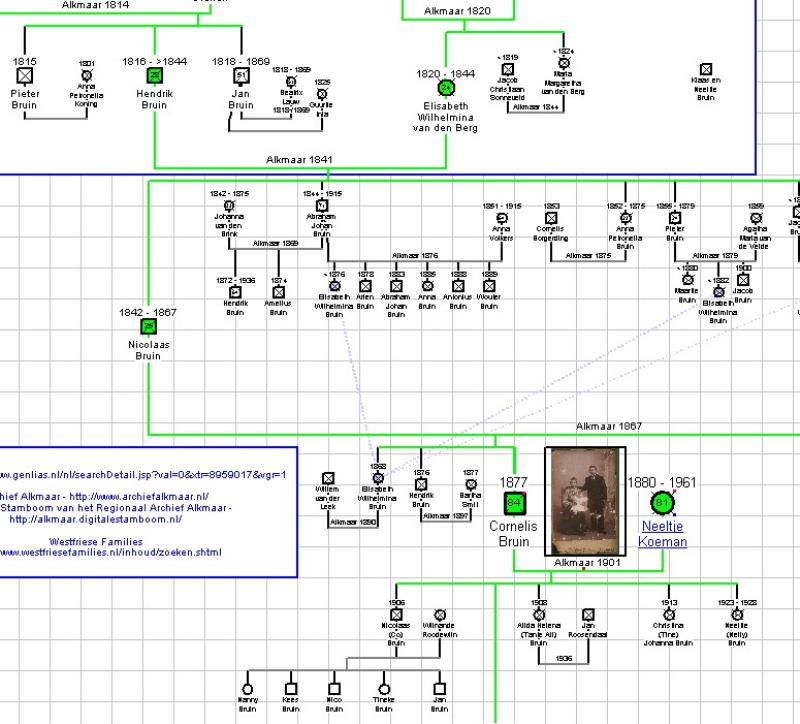|
By 731819 - Wednesday, August 4, 2010
|
Some connecting lines are gray while some are black.
I understand that this has something to do with the nature of the relationship.
But I want all the lines to be black, regardless of the relationship.
How do I make all of the lines black?
|
|
By appleshaw - Wednesday, August 4, 2010
|
Never noticed this before. Old eyes?
More detailed look suggests vertical lines are black but horizontal family lines when Automatic are grey.
You can of course select a line and change its colour but each one has to be adjusted individually. It may be possible to set the Automatic colour of family lines to black, but I can not yet see how to do this.
|
|
By Barry Graham - Wednesday, August 4, 2010
|
Taking this a step further.
When a partner relationship is added to the Genomap the default relationship is null.
This results in an automatic grey line.
Since the majority of partner relationships in a family tree are marriages shouldn't MARRIAGE be the default?
The automatic line colour for a marriage is black.
I'd like to see a set of preferences where you could set such things as default relationship, age never, deceased cross never etc. by choice rather than having to set or amend the program defaults.
|
|
By GenoProSupport - Wednesday, August 4, 2010
|
|
By default, GenoPro pick a color depending on the family relation. For instance, an unknown relation is displayed in gray, a marriage is in black, a divorce is displayed in red. To change the color of family relation, double-click on the horizontal line to bring the Family Properties. You will see a drop-down option overwrite the default color: 
You may also overwrite the color of the pedigree link (the vertical lines in the family tree)
|
|
By Howard53 - Thursday, August 5, 2010
|
Related to this, I pointed out many years ago that you can select multiple Gender Symbols and change any of their properties in a single operation from the right-click Properties menu; however, selecting multiple connecting lines, whether Relationship Lines, Family Lines, or both, the only change that can be made is to the thickness or position of the selected lines - the Properties menu only allows you to change the Gender defaults.
This means that changing the colour of multiple lines, for whatever reason, is a tedious process.
|
|
By Onno - Friday, February 11, 2011
|
|
Howard53 (05-Aug-2010)
Related to this, I pointed out many years ago that you can select multiple Gender Symbols and change any of their properties in a single operation from the right-click Properties menu; however, selecting multiple connecting lines, whether Relationship Lines, Family Lines, or both, the only change that can be made is to the thickness or position of the selected lines - the Properties menu only allows you to change the Gender defaults.
This means that changing the colour of multiple lines, for whatever reason, is a tedious process.
Yes... I would love to see a button which would identify the direct family of a person... Would safe me a lot of time...  The possibility to define the lines of direct family of the selected person would make the tree look a lot better... Is there a "script" that would identify direct family... A desendent tree...?
|
|
By Howard53 - Saturday, February 12, 2011
|
|
You can select the direct descendants of any individual by selecting that individual, right-clicking the selection, and choosing Select>Select Direct Descendants. You can then change the size of the selected individuals and connecting lines, but, as I pointed out in the earlier post, although you can change the colours of all the selected gender symbols, you cannot change the colour of the connecting lines.
|
|
By Onno - Thursday, February 17, 2011
|
|
Howard53 (12-Feb-2011)
You can select the direct descendants of any individual by selecting that individual, right-clicking the selection, and choosing Select>Select Direct Descendants. You can then change the size of the selected individuals and connecting lines, but, as I pointed out in the earlier post, although you can change the colours of all the selected gender symbols, you cannot change the colour of the connecting lines.Thanks.. Yes... I noticed and that's a great feature. For me, it's just the 4 lines between two persons that I "need" to color.... Anyway... enjoying the program.. and the possibility of integrating pictures make it even more interesting... |
|
By powery - Monday, March 28, 2011
|
|
Why is not possible to copy and paste color (in hex format) in Pedigree Links window in Display Color column? It should solve the problem of multiple line color changes.
|
|
By Jakk - Monday, May 6, 2013
|
|
To pick up on this again after two years, I would love to see the selection of multiple relationships bring up the same kind of window (visual properties) that comes up when multiple people are selected. This would save me an immense amount of time. Failing that, it would have been nice (as another user mentioned) for "marriage" to be the default relationship status.
|
|
By Jakk - Monday, May 6, 2013
|
|
And yes, I know it means that the user has to remove information in the case of unmarried relationships, but for those of us who don't think to check for such things when we start using the program as newbies and create a LOT of genograms in the default setting, being able to change multiple relationships with one set of mouse clicks would be most helpful.
|
|
By SurreyJohn - Friday, November 13, 2020
|
|
After using GenoPro for year and years I've just discovered how to change the default colours (by accident). Select two or more objects and then select "properties". An extra tab allows the changing of the default values. Is there a Video or PDF help file available to download. p.s. I would expect to change defaults in the Options area.
|